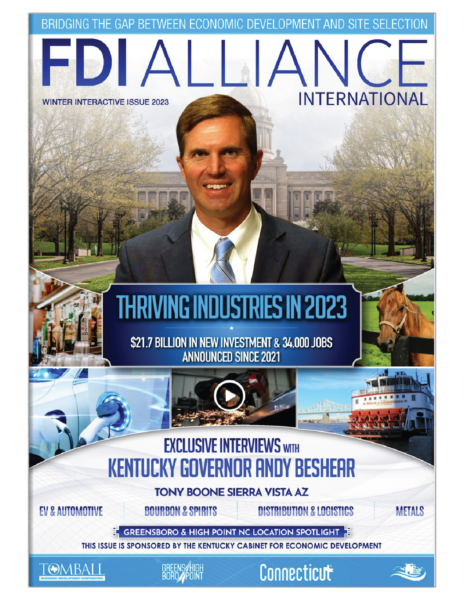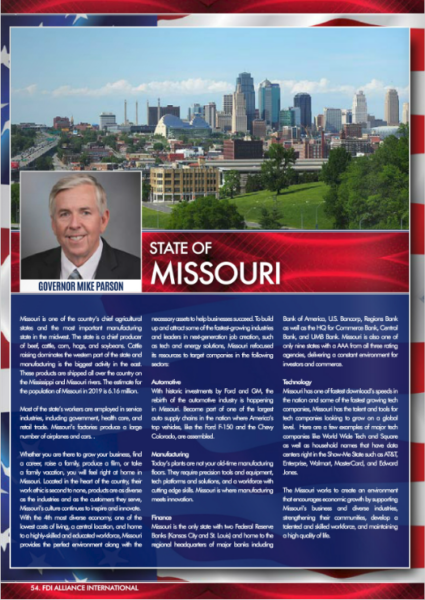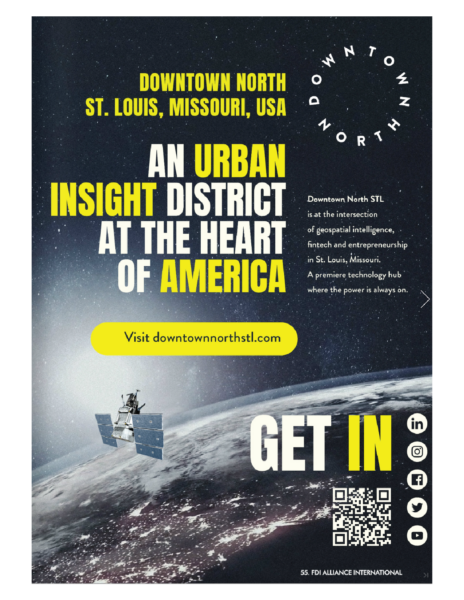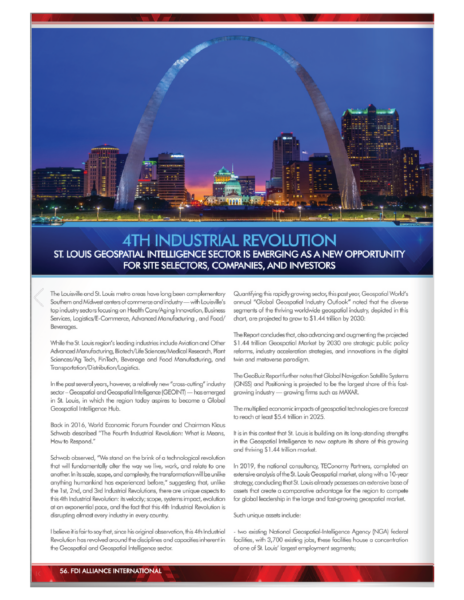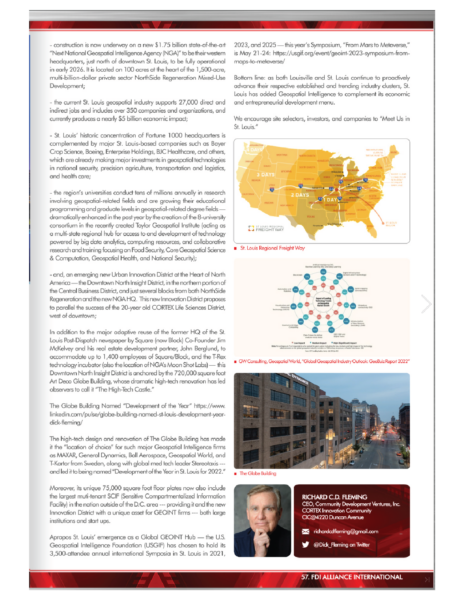4th Industrial Revolution
Written by Dick Fleming | Originally Published in Foreign Direct Investment Alliance (FDI) Magazine
The Louisville and St. Louis metro areas have long been complementary Southern and Midwest centers of commerce and industry — with Louisville’s top industry sectors focusing on Health Care/Aging Innovation, Business Services, Logistics/E-Commerce, Advanced Manufacturing, and Food/Beverages.
In the past several years, however, a relatively new “cross-cutting” industry sector – Geospatial and Geospatial Intelligence (GEOINT) — has emerged in St. Louis, in which the region today aspires to become a Global Geospatial Intelligence Hub.
Back in 2016, World Economic Forum Founder and Chairman Klaus Schwab described “The Fourth Industrial Revolution: What is Means, How to Respond.”
Schwab observed, “We stand on the brink of a technological revolution that will fundamentally alter the way we live, work, and relate to one another. In its scale, scope, and complexity, the transformation will be unlike anything humankind has experienced before,” suggesting that, unlike the 1st, 2nd, and 3rd Industrial Revolutions, there are unique aspects to this 4th Industrial Revolution: its velocity; scope, systems impact, evolution at an exponential pace, and the fact that this 4th Industrial Revolution is disrupting almost every industry in every country.
I believe it is fair to say that, since his original observation, this 4th Industrial Revolution has revolved around the disciplines and capacities inherent in the Geospatial and Geospatial Intelligence sector.
Quantifying this rapidly growing sector, this past year, Geospatial World’s annual “Global Geospatial Industry Outlook” noted that the diverse segments of the thriving worldwide geospatial industry, depicted in this chart, are projected to grow to $1.44 trillion by 2030:
The Report concludes that also advancing and augmenting the projected $1.44 trillion Geospatial Market by 2030 are strategic public policy reforms, industry acceleration strategies, and innovations in the digital twin and metaverse paradigm.
The GeoBuiz Report further notes that Global Navigation Satellite Systems (GNSS) and Positioning is projected to be the largest share of this fast-growing industry — growing firms such as MAXAR.
The multiplied economic impacts of geospatial technologies are forecast to reach at least $5.4 trillion in 2025.
It is in this context that St. Louis is building on its long-standing strengths in Geospatial Intelligence to now capture its share of this growing and thriving $1.44 trillion market.
In 2019, the national consultancy, TEConomy Partners, completed an extensive analysis of the St. Louis Geospatial market, along with a 10-year strategy, concluding that St. Louis already possesses an extensive base of assets that create a comparative advantage for the region to compete for global leadership in the large and fast-growing geospatial market.
Such unique assets include:
Two existing National Geospatial-Intelligence Agency (NGA) federal facilities, with 3,700 existing jobs, these facilities house a concentration of one of St. Louis’ largest employment segments
Construction is now underway on a new $1.75 billion state-of-the-art “Next National Geospatial Intelligence Agency (NGA)” to be their western headquarters, just north of downtown St. Louis, to be fully operational in early 2026. It is located on 100 acres at the heart of the 1,500-acre, multi-billion-dollar private sector NorthSide Regeneration Mixed-Use Development
The current St. Louis geospatial industry supports 27,000 direct and indirect jobs and includes over 350 companies and organizations, and currently produces a nearly $5 billion economic impact
St. Louis’ historic concentration of Fortune 1000 headquarters is complemented by major St. Louis-based companies such as Bayer Crop Science, Boeing, Enterprise Holdings, BJC Healthcare, and others, which are already making major investments in geospatial technologies in national security, precision agriculture, transportation and logistics, and health care
The region’s universities conduct tens of millions annually in research involving geospatial-related fields and are growing their educational programming and graduate levels in geospatial-related degree fields — dramatically enhanced in the past year by the creation of the 8-university consortium in the recently created Taylor Geospatial Institute (acting as a multi-state regional hub for access to and development of technology powered by big data analytics, computing resources, and collaborative research and training focusing on Food Security, Core Geospatial Science & Computation, Geospatial Health, and National Security)
An emerging new Urban Innovation District at the Heart of North America — the Downtown North Insight District, in the northern portion of the Central Business District, and just several blocks from both NorthSide Regeneration and the new NGA HQ. This new Innovation District proposes to parallel the success of the 20-year-old CORTEX Life Sciences District, west of downtown
In addition to the major adaptive reuse of the former HQ of the St. Louis Post-Dispatch newspaper by Square (now Block) Co-Founder Jim McKelvey and his real estate development partner, John Berglund, to accommodate up to 1,400 employees of Square/Block, and the T-Rex technology incubator (also the location of NGA’s Moon Shot Labs) — this Downtown North Insight District is anchored by the 720,000 square foot Art Deco Globe Building, whose dramatic high-tech renovation has led observers to call it “The High-Tech Castle.”
The high-tech design and renovation of The Globe Building have made it the “location of choice” for such major Geospatial Intelligence firms as MAXAR, General Dynamics, Ball Aerospace, Geospatial World, and T-Kartor from Sweden, along with global med tech leader Stereotaxis — and led it to be named “Development of the Year in St. Louis for 2022.”
Moreover, its unique 75,000 square foot floor plates now also include the largest muti-tenant SCIF (Sensitive Compartmentalized Information Facility) in the nation outside of the D.C. area — providing it and the new Innovation District with a unique asset for GEOINT firms — both large institutions and start-ups.
Apropos St. Louis’ emergence as a Global GEOINT Hub — the U.S. Geospatial Intelligence Foundation (USGIF) has chosen to hold its 3,500-attendee annual international Symposia in St. Louis in 2021, 2023, and 2025 — this year’s Symposium, “From Mars to Metaverse,” is May 21-24
Bottom line: as both Louisville and St. Louis continue to proactively advance their respective established and trending industry clusters, St. Louis has added Geospatial Intelligence to complement its economic and entrepreneurial development menu.
We encourage site selectors, investors, and companies to “Meet Us in St. Louis.”
— Richard C.D. Fleming, CEO, Community Development Ventures, Inc.,
Click the images below to read more of Foreign Direct Investment Alliance (FDI) Magazine


